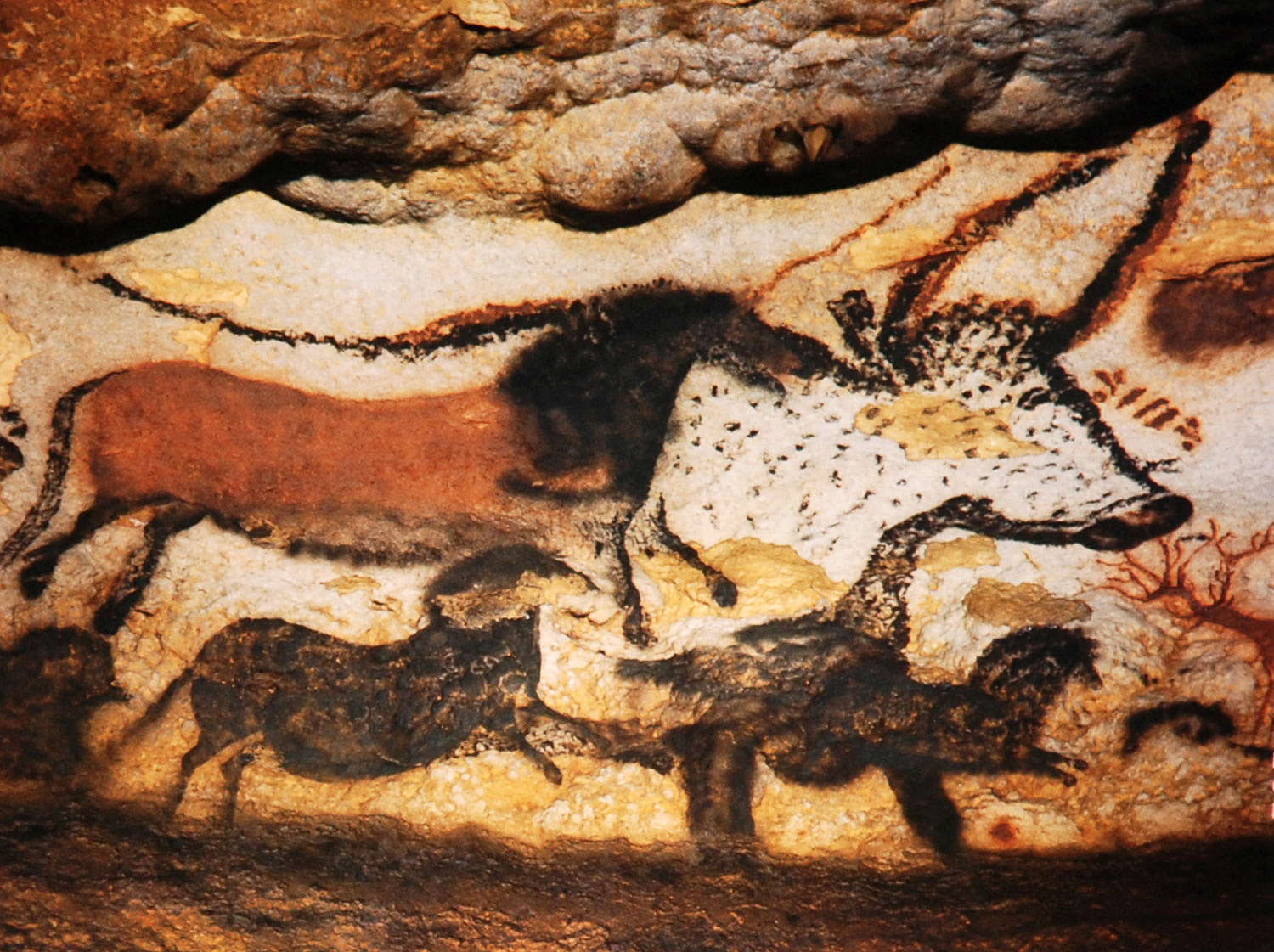
Cave Painting, c. 15,000-10,000 BC, Lascaux, France
Archeologists have identified 4 basic types of Stone Age art, as follows: petroglyphs (cupules, rock carvings and engravings); pictographs (pictorial imagery, ideomorphs, ideograms or symbols), a category that includes cave painting and drawing; and prehistoric sculpture (including small totemic statuettes known as Venus Figurines, various forms of zoomorphic and therianthropic ivory carving, and relief sculptures); and megalithic art (petroforms or any other works associated with arrangements of stones). Works that are applied to an immoveable rock surface are classified as parietal art; works that are portable are classified as mobiliary art.
Not content with simply making tools, Homo sapiens and later modern man created a huge range of Stone Age art, beginning with primitive Acheulean culture petroglyphs – such as cupules and rock carvings – and ending in stunning works of prehistoric sculpture (like the venus figurines), and the beautiful Magdalenian era cave paintings of Altamira.
Stone Age artists used every sort of material they could find, ranging from rock-hard quartzite to softer stones like steatite, serpentine, sandstone and limestone, as well as mammoth ivory, reindeer antler, and animal bones. For colour, they used a range of red, yellow and brown ochres, manganese dioxide and charcoal.
Art of the later Neolithic period is exemplified by exquisite ceramics, magnificent early bronze and gold castings, and the monumental architecture of the pyramids, ziggurats and megalithic structures of Newgrange and Stonehenge. Brought to life thanks to the efforts of archeologists and paleoanthropologists, the art of prehistory remains an integral chapter in the evolution of man.
Prehistoric art is dominated by parietal rock art, such as cave painting and petroglyphs. Sculpture, being a portable form of art and thus more prone to destruction or loss, is less common, though no less significant in revealing the intellectual and artistic progress of the culture or artist involved. After all, plastic art is invariably more challenging and complex than two-dimensional arts such as drawing or painting.
Not surprisingly, therefore, as Stone Age tools improved in quality – from primitive all-purpose implements to highly specialized instruments with differing shapes, blades and weights – so did Stone Age art. Not surprisingly, therefore, the arrival of anatomically modern man, who replaced Neanderthal Man during the period (c.50-20,000 BCE), had a major impact on both tool culture and sculpture in the Upper Paleolithic era, notably during the Aurignacian, Gravettian and Magdalenian periods.
Characteristics
The earliest forms of prehistoric art are extremely primitive. The cupule, for instance – a mysterious type of Paleolithic cultural marking – amounts to no more than a hemispherical or cup-like scouring of the rock surface. The early sculptures known as the Venuses of Tan-Tan and Berekhat Ram, are such crude representations of humanoid shapes that some experts doubt whether they are works of art at all.
It is not until the Upper Paleolithic (from roughly 40,000 BCE onwards) that anatomically modern man produces recognizable carvings and pictures. Aurignacian culture, in particular, witnesses an explosion of rock art, including the cave murals at Chauvet, the Venus of Hohle Fels, the animal carvings of the Swabian Jura, the Venus of Kostenky, Aboriginal Rock Art from Australia, the Lion Man of Hohlenstein-Stadel and much more.
The later Gravettian and Magdalenian cultures gave birth to even more sophisticated versions of prehistoric art, notably the polychrome Dappled Horses of Pech-Merle and the sensational cave paintings at Lascaux and Altamira.
Dating of Prehistoric Art
A number of highly sophisticated techniques – such as radiometric testing and thermoluminescence – are now available to help establish the date of ancient artifacts from the Paleolithic era and later. However, dating of ancient art is not an exact science, and results are often dependent on tests performed on the ‘layer’ of earth and debris in which the artifact was lying, or – in the case of rock engraving – an analysis of the content and style of the markings. (Animal drawings using regular side-profiles, for instance, are typically older than those using three-quarter profiles.)
Art Encyclopedia
Visual Arts of Painting – Sculpture – Architecture
PAGE CONTENTS
• What is Art?
• World’s Greatest Painters
• Best Modern Painters
• Art History
• News
• Painting
• Sculpture
• Architecture
• Irish Arts
• World Art
• Museums
• Art Appreciation
• Famous Paintings Analyzed
MOST POPULAR ARTICLES
• Top 10 Most Expensive Paintings
See the world’s costliest pictures.
• Best Artists of All Time
Who exactly are the 10 greatest painters and sculptors?
• History of Art Timeline
All major arts events since the Iron Age – on one page!
• Cave Painting
Amazing facts about Stone Age cave art.
• Impressionism: A Complete Guide
The genius of Monet, Pissarro, Renoir, and others.
• Jewellery Art – History and Techniques
The fascinating story of precious objects.
>>>>>> SEE MORE MOST POPULAR ARTICLES
TO FIND A SPECIFIC TOPIC, USE OUR EASY A-Z INDEX

“The BEST educational arts site on the web…”
Filed under: Uncategorized
